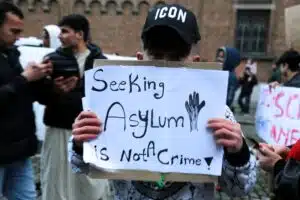Brussels – According to the European Parliament negotiators, this is “a historic day.” However, at the end of the trilogues marathon on the New Pact on Migration and Asylum, only the Spanish presidency of the Council of the European Union can celebrate, as it will come back to the 27 Member States with a compromise agreement almost identical to their negotiating mandate on all files. “I don’t see a possibility of not having an agreement” before the 2024 European elections, the President of the European Parliament, Roberta Metsola, clearly stated some days ago. Now, the deal is on the table at the expenses of MEPs, as they abandoned all the red lines and guarantees in their original negotiating position.
 The basis for the new Pact on Migration and Asylum is the relationship between solidarity and responsibility in managing migration. The first concept is the basis of the Regulation for the Management of Asylum and Migration (RAMM), which in no way overrides the cardinal principle of the 2013 Dublin Regulation, namely that the task of examining the asylum claim of a person who enters the EU territory irregularly lies with the first EU member state of entry. Countries including Italy, Greece, Malta, Cyprus, and Spain will be responsible for applications. Other member states that want to ‘dublin’ (i.e., extradite) these migrants – including minors and those applying for reunification with siblings – will have to send a notification, no longer a reciprocal due process request with the agreement of the country of first arrival as is the case today. After the Regulation enters into force – 24 months after its publication in the EU Official Journal – the now famous mandatory solidarity mechanism will be introduced for all 27 countries (based on GDP and population), which equalizes three forms of solidarity: relocations of migrants, financial contributions, or sending funds to third countries. Contributions to border states can be directed not only to reception systems but also to fund fixed and mobile border facilities through the Border and Visa Management Instrument (BMVI). There will be no mandatory relocation for migrants disembarked after search and rescue operations at sea, and for those under the RAMM procedure, there is no legal representation, only counseling.
The basis for the new Pact on Migration and Asylum is the relationship between solidarity and responsibility in managing migration. The first concept is the basis of the Regulation for the Management of Asylum and Migration (RAMM), which in no way overrides the cardinal principle of the 2013 Dublin Regulation, namely that the task of examining the asylum claim of a person who enters the EU territory irregularly lies with the first EU member state of entry. Countries including Italy, Greece, Malta, Cyprus, and Spain will be responsible for applications. Other member states that want to ‘dublin’ (i.e., extradite) these migrants – including minors and those applying for reunification with siblings – will have to send a notification, no longer a reciprocal due process request with the agreement of the country of first arrival as is the case today. After the Regulation enters into force – 24 months after its publication in the EU Official Journal – the now famous mandatory solidarity mechanism will be introduced for all 27 countries (based on GDP and population), which equalizes three forms of solidarity: relocations of migrants, financial contributions, or sending funds to third countries. Contributions to border states can be directed not only to reception systems but also to fund fixed and mobile border facilities through the Border and Visa Management Instrument (BMVI). There will be no mandatory relocation for migrants disembarked after search and rescue operations at sea, and for those under the RAMM procedure, there is no legal representation, only counseling.
The concept of accountability is particularly linked to the Asylum Procedures Regulation (APR), which increases only those provided for countries of first entry. It will apply automatically in case of risk for security threat issues – including unaccompanied minors – of “deception of authorities” or if the migrant comes from a country with a recognition rate of less than 20 percent. Border procedures will provide de facto detention, with no exemptions even for families with children under 12, nor legal representation, nor a stay for appeals against most decisions (the exception is for inadmissibility of those based on the concept of “safe third country” and for unaccompanied minors). Crucial to this Regulation is precisely the “Safe Third Country” concept, for which both an EU list and national lists are provided to justify and expedite rapid returns out of the Union unless there are links of the individual person to the state in question that preclude their safety. New accountability obligations include completing the examination of an asylum application through the border procedure within six months (APR), but also extending the period of responsibility for handling applications for 20 months and maintaining at 12 months that for search and rescue operations at sea (RAMM). The annual ceiling for border procedures is set at 30,000 people, determined based on a formula that takes into account the number of irregular border crossings and the number of expulsions in the previous three years.
What happens when migrants arrive

Once migrants arrive at the Union’s borders, the Screening Regulation of the Pact on Migration and Asylum will provide a 7-day detention procedure for the division between regular (RAMM) or expedited (APR) procedures to process their asylum claims. Since the so-called ‘fiction of non-entry’ has remained – that is, that anyone screened in a special center will not be considered legally on the territory of the member state and therefore of the EU – in fact, migrants will be detained as they will have to remain at the disposal of the authorities without the possibility of entering national soil. Some guarantees include the possibility for applicants to have access to a copy of the screening form and the preservation of the “relevant rules on detention” set out in the 2008 Return Directive (the revision contained in the Pact on Migration and Asylum is the only dossier that is certain to fail). But the monitoring mechanism – which does not include NGOs – does not apply to border surveillance activities (with the normalization of racial profiling). If the State recognizes a security threat, it can grant national authorities direct access to all data on the person in all databases.
Regarding databases, according to the Eurodac Regulation, all migrant persons benefiting from temporary protection from the age of 6 will have to accept the collection of their biometric data, even though under the General Data Protection Regulation (GDPR), processing is lawful only if the minor is at least 16 years old. Expansion of data access for national authorities includes collecting photographic data of faces, effectively giving the green light to mass surveillance of people arriving on EU soil. Security alerts to be entered into the Eurodac database during the screening process and order procedures will include a whole range of new categories – such as irregular border crossing – also through the revision of the Entry and Exit System Review Regulation.
Crisis situations under the new Pact on Migration and Asylum
 One of the most controversial items in the Pact on Migration and Asylum is the Crisis, Force Majeure and Instrumentation Regulation, which deals with times when there is an exceptional or unexpected “mass arrival of people,” including following disembarkation after a search and rescue operation at sea. The Council negotiating position passed, which led to the inclusion of instrumentality (a Regulation that was initially a stand-alone and on which Parliament had not given the green light) for crises and force majeure in cases where “a hostile third country or non-state actor encourages or facilitates the movement of third-country nationals and stateless persons” towards the EU external borders “with the aim to destabilize the Union or a Member State” by putting “the essential functions of a Member State at risk.” NGOs are excluded from this definition, but only if they can demonstrate that their actions (at sea and otherwise) do not aim to destabilize, with clear risks of repercussions for the criminalization of solidarity.
One of the most controversial items in the Pact on Migration and Asylum is the Crisis, Force Majeure and Instrumentation Regulation, which deals with times when there is an exceptional or unexpected “mass arrival of people,” including following disembarkation after a search and rescue operation at sea. The Council negotiating position passed, which led to the inclusion of instrumentality (a Regulation that was initially a stand-alone and on which Parliament had not given the green light) for crises and force majeure in cases where “a hostile third country or non-state actor encourages or facilitates the movement of third-country nationals and stateless persons” towards the EU external borders “with the aim to destabilize the Union or a Member State” by putting “the essential functions of a Member State at risk.” NGOs are excluded from this definition, but only if they can demonstrate that their actions (at sea and otherwise) do not aim to destabilize, with clear risks of repercussions for the criminalization of solidarity.
Not even in crisis situations are there mandatory relocations of migrants between member countries, but the same three modes of solidarity as in the RAMM Regulation (relocations, financial contributions or sending funds to third countries) will apply. Instead, in this scenario, derogations to the overall migration and asylum management system will kick in in: the recognition rate threshold for which people can be admitted to border procedures (under the APR Regulation at 20 percent) is raised to 50 percent in force majeure situations, to 60/70 percent in crisis situations, and to 100 percent in case of instrumentalization. Again, from the border procedures – the duration of which can be extended by an additional six weeks (compared to the 9 months in Apr) – families with children under the age of 12 are not excluded.
English version by the Translation Service of Withub



